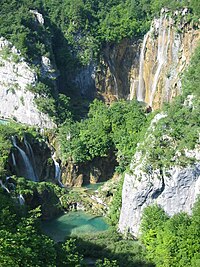
Photo from wikipedia
In this study, the influence of anthropogenic pollution on the aquatic environment of Plitvice Lakes National Park (PLNP) was investigated during 2011–2012 using a combination of chemical and cytogenetic analyses.… Click to show full abstract
In this study, the influence of anthropogenic pollution on the aquatic environment of Plitvice Lakes National Park (PLNP) was investigated during 2011–2012 using a combination of chemical and cytogenetic analyses. Four groups of major contaminants [(volatile organic compounds: benzene, toluene, ethylbenzene, and xylenes (BTEX); persistent organochlorine pollutants: organochlorine pesticides (OCPs) and polychlorinated biphenyls (PCBs); major and trace elements; anthropogenic radionuclides (90Sr, 134Cs, and 137Cs)] were determined in three aquatic compartments (water, sediment, fish). Mass fractions of inorganic constituents in different compartments reflected the geological background of the area, indicating their origin from predominantly natural sources. Levels of volatile and persistent organic compounds in water and fish, respectively, were very low, at levels typical for remote pristine areas. Analysis of anthropogenic radionuclides in water and sediment revealed elevated activity concentrations of 137Cs in water, and measurable 134Cs in the upper sediment layers from April 2011, possibly as a consequence of the Fukushima nuclear accident in March 2011. The potential genotoxicity of river and lake water and lake sediment was assessed under laboratory conditions using the alkaline comet assay on human peripheral blood lymphocytes, and measured levels of primary DNA damage were within acceptable boundaries. The results showed that despite the protected status of the park, anthropogenic impact exists in both its terrestrial and aquatic components. Although contaminant levels were low, further monitoring is recommended to make sure that they will not rise and cause potentially hazardous anthropogenic impacts.
Journal Title: Environmental Monitoring and Assessment
Year Published: 2018
Link to full text (if available)
Share on Social Media: Sign Up to like & get
recommendations!